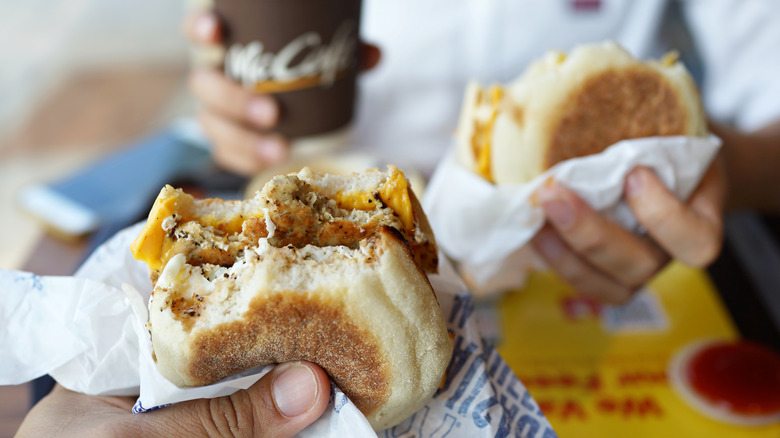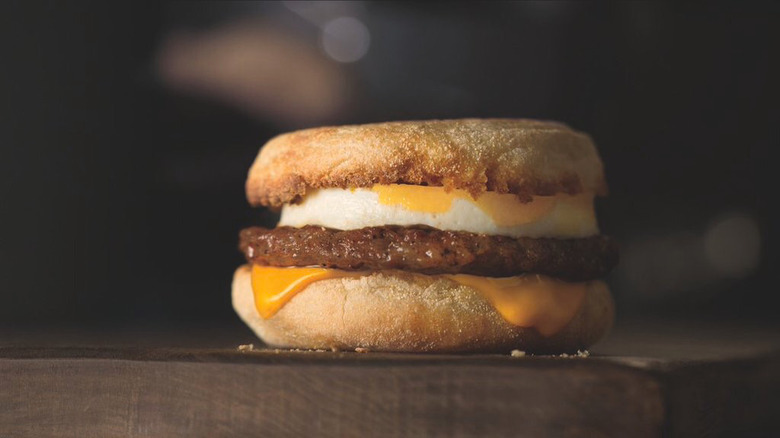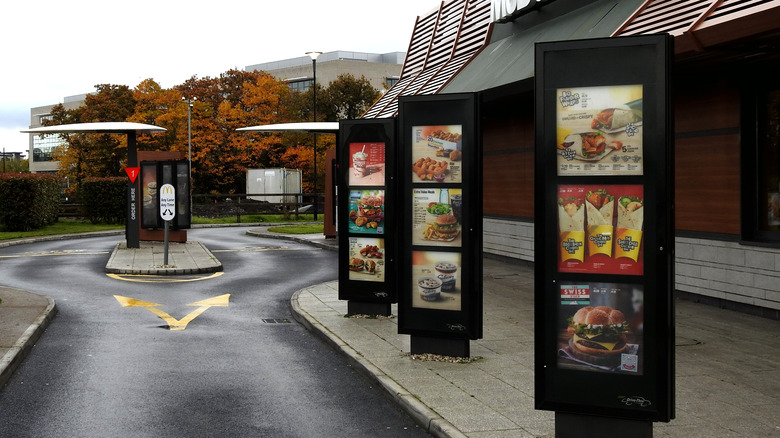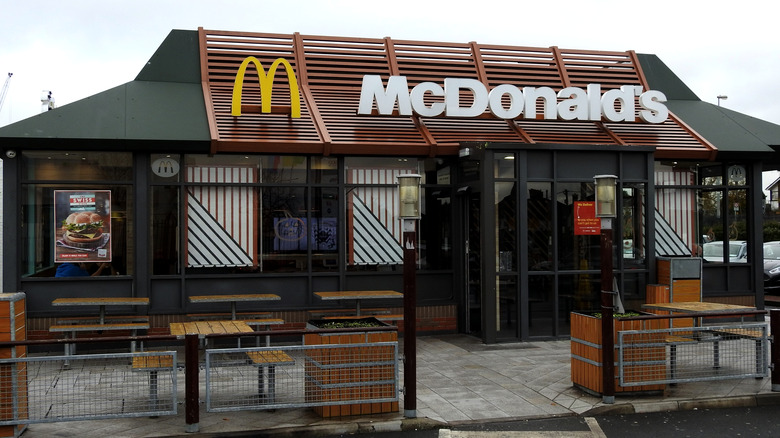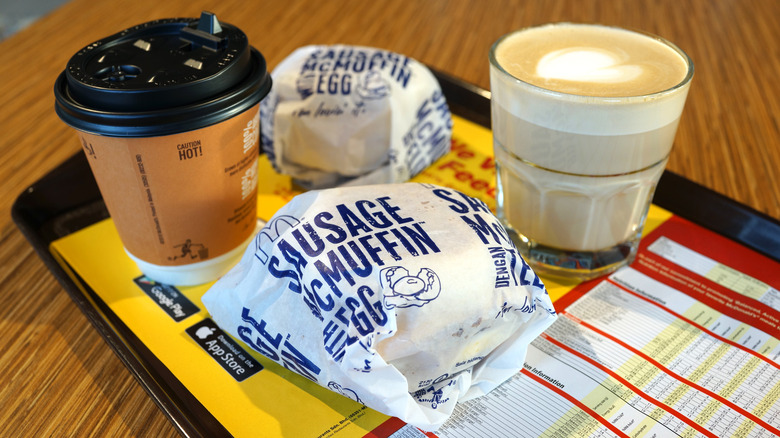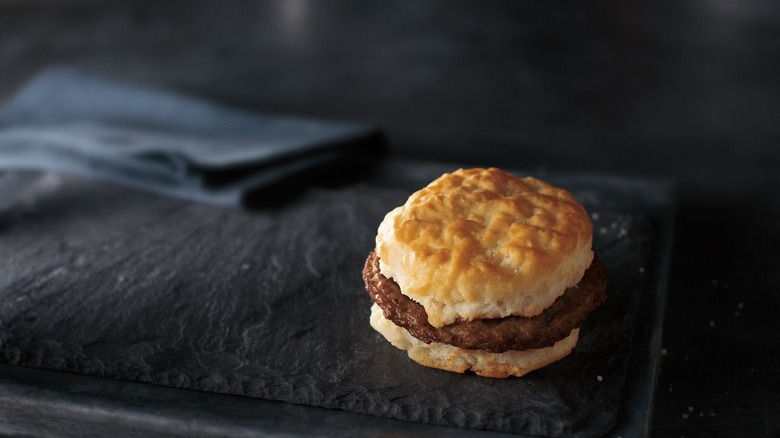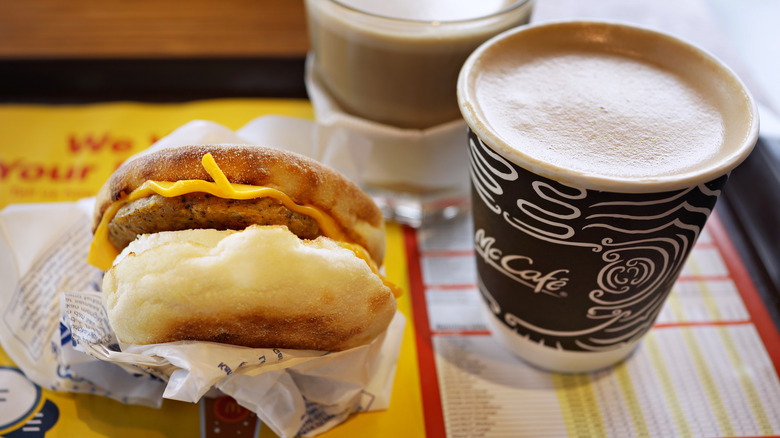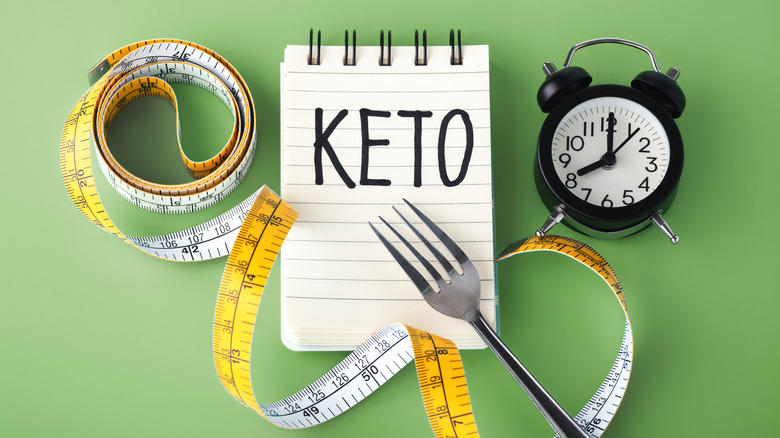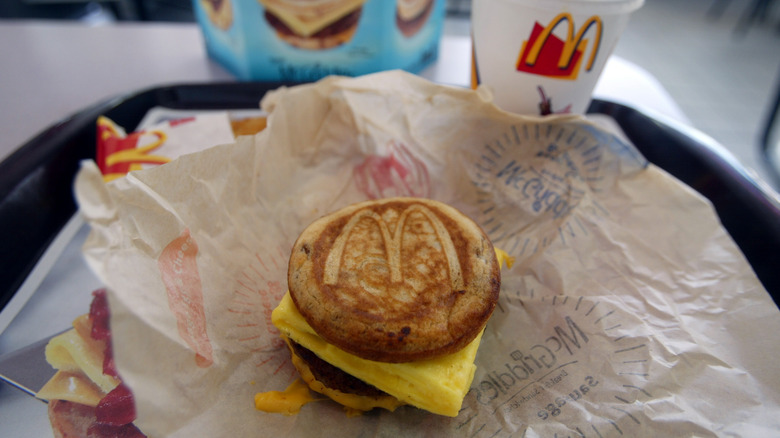The Truth About McDonald's Breakfast Sausage
No other fast food joint does mornings quite like McDonald's. For over 40 years, their breakfast menu has fueled groggy customers' grease fix with hash browns, hot cakes, and grilled breakfast sandwiches, washed down with a steady stream of black coffee. But when talking about McDonald's breakfast, we tend to focus on individual innovations like the Sausage McMuffin or the McGriddle. What we don't pay much attention to is what's nestled in between the bun, and that's McDonald's breakfast sausage.
These little meat patties lay the foundation for many of the beloved bites millions flock to the drive-thru for, yet most people probably don't give them much thought. There's so much more to the sausage than what's on the surface. From the flavorful meat to its surprising nutritional value, the history of McDonald's breakfast sausage carries a direct link to the history of the Golden Arches itself. Seeing how the sausage is made, as the age-old phrase goes, can bring to mind stomach-churning facts you'd be better off not knowing. But we think the facts here will only enhance your enjoyment of the most important (fast food) meal of the day. Here's the sizzling truth about McDonald's breakfast sausage.
McDonald's breakfast sausage is made of pork
Whether it's from the drive-thru window or the freezer section of the supermarket, most breakfast sausages you come across are going to be made out of pork. Unsurprisingly, this includes the sausage patties at McDonald's. As the chain's nutritional information posted online shows, pork is listed as the first ingredient, followed by water, salt, and spices (via McDonald's). Additionally, the sausage also contains "natural flavors," which consist of the intrinsic properties already present in the meat itself, per Healthline. These additives reinforce the salty, slightly sweet flavor that makes breakfast sausage taste like, well, breakfast sausage.
Diet-friendly alternatives to pork have emerged on pancake platters in recent years (turkey bacon, anyone?), but it's easy to see why the pig dominates the breakfast market to this day. For one, pork is versatile. As S. Clyde Weaver notes, "fresh country sausage" developed out of the need for farmers to put meat scraps to good use. Taking these unwanted fragments, they'd grind them into patties and season them with fresh herbs such as thyme, sage, and rosemary (via Southern Living). This lends an aromatic depth to the already flavorful meat, and further makes the case for a sticky, syrup-soaked hot cake to go with it.
Breakfast sausage wasn't always on the menu
It's true that McDonald's dabbled in breakfast for a couple years prior to the morning menu's official launch in 1977. During this period, however, there was a noticeable, meat-sized hole in the menu, and that was none other than the absence of breakfast sausage. That's right, for a hot minute in Mickey D's breakfast history, sausage was not on the menu. A company timeline provided by McDonald's reveals that the only breakfast item customers could grab for a brief time was the Egg McMuffin, which didn't arrive in restaurants until 1975 (via Foodbeast). Two years is a long time, and for busy customers in need of a quick bite before work, the McDonald's drive-thru didn't leave many options.
But good things come for those who wait, so when breakfast was finally served nationally, ground pork patties finally made their first appearance. A vintage TV commercial from the 1970s shows customers could snag a side of breakfast sausage in two entrees that are still around today, the Big Breakfast and Hot Cakes and Sausage. Additionally, the sausage could also be ordered a la carte, letting consumers customize their own morning meal on the go. Even then, it still took another few years before the breakfast sandwich took off, starting with the Sausage Biscuit in 1986 and McGriddle in 2003.
You can't buy it from the store
Assuming you have English muffins on hand and some Jimmy Dean patties stashed away in the freezer, you could probably whip up a decent Sausage McMuffin at home, right? Probably, but only to an extent. For starters, McDonald's breakfast sausage is not commercially available to the public. It's exclusively produced for the restaurant, meaning you can't buy it directly from the store. As McDonald's website notes, meat processor Lopez-Dorada Foods supplies the chain's meats, covering everything from the ground beef of Big Macs to the sausage crumbled inside breakfast burritos. Over a quarter of pork products found at McDonald's come straight from Lopez-Dorada Foods (per High Plains Journal).
The Oklahoma-based corporation, which also shares ties with Tyson Foods and Walmart, has backed McDonald's meat supply since 1968. As we've previously established, McDonald's wouldn't begin serving breakfast for another decade, which puts the processor at a high advantage in the chain's pivot to a new menu. The fact that they've forged a partnership with this much longevity is likely to reflect in the consistency of the product itself. Recreating your favorite fast food breakfast from scratch is a tantalizing prospect — it's cheaper, and not waiting in line is a plus. But when it comes to a sausage patty from Mickey D's, it turns out there's only so much the average home cook can duplicate.
Breakfast sausage from McDonald's is surprisingly low in sodium
Breakfast sausage is a vessel for salt, fat, and grease. AKA , the holy trinity that makes all things delicious. That also means it isn't super healthy to eat on a regular basis (bummer). Yet tucked inside these mouthwatering meat patties is an interesting nugget of truth, and that's this: McDonald's breakfast sausage is surprisingly light on the salt. If you take a glance at the restaurant's nutritional calculator, you'll discover that the sodium content in the breakfast sausage from Mickey D's is actually quite fair, given its artery-clogging reputation.
Eating a breakfast sausage patty from McDonald's contains 280 mg of sodium, which amounts to 12% of your daily recommended intake (per McDonald's). Putting things into perspective, the Centers for Disease Control and Prevention suggests consuming no more than 2300 mg of sodium in a given day. Therefore, this makes it a drop in the bucket of your total allowance. Granted, we're only talking the sausage here, and a single sausage at that. This means no egg, no cheese, and definitely no carb-loaded griddle cake to contend with. But compared to the other sodium-bombs scattered across McDonald's menu, you could do plenty worse for a mid-morning protein boost. The Sausage McMuffin with Egg, for example, boasts 830 mg of sodium, while the Sausage, Egg, & Cheese McGriddle packs a mighty punch at 1290 mg — over half your day's worth of salt (yikes).
There's no artificial preservatives
Food transparency is a trend that's here to stay, and even the Golden Arches aren't immune from heeding the call. In 2018, McDonald's announced they would be scrapping all artificial preservatives found in many of their menu items, such as hamburger buns, scrambled eggs, and chicken nuggets. Of course, these improvement efforts meant no part of the menu was left untouched, so the humble breakfast sausage received a much-needed overhaul as well.
As we've laid out, the breakfast sausage currently contains eight ingredients: pork, water, salt, spices, dextrose, sugar, rosemary extract, and natural flavors (per McDonald's). However, a Reddit poster managed to hunt down the old nutritional information from the late aughts, and the differences are shocking. A sausage patty from 2009 would have been filled with a long list of additives such as corn syrup solids, monosodium glutamate (MSG), propyl gallate, and citric acids. The only one left standing in the new version is dextrose, a simple sugar that mimics the role of glucose within our bodies and can be broken down and used as a source of energy (per Healthline).
It's also dairy-free
The butter soaking through your pancakes or creamer in your coffee? Those aren't the only parts of your breakfast containing dairy. According to Johns Hopkins Medicine, milk is commonly added to skillet-friendly meats like breakfast sausage, as the proteins help bulk out the meat during the production process (per Verywell Fit). This may not cross your mind in the hunger-filled haze of consuming a morning McGriddle, but it will if you're among the 68% of people who experience lactose malabsorption worldwide (via National Institute of Diabetes and Digestive and Kidney Diseases).
In addition to its absence of preservatives, McDonald's breakfast sausage is an outlier in that it doesn't contain any milk. We've established McDonald's push towards natural ingredients, and it's evident that part of their ingredient transparency efforts extends to cutting dairy from pork products. The Reddit post detailing the sausage's past nutritional information displays milk as a prominent ingredient, but its absence on the menu today clearly shows it got the boot. Go Dairy Free even offers a guide on dairy-free substitutions at McDonald's, among them the Sausage McMuffin and Sausage McMuffin with Egg, whose lactose-free status can be achieved by nixing the butter and cheese from the sandwich. No one should have to deny themselves the pleasure of a McDonald's breakfast sausage, and thankfully those with dairy allergies don't have to.
McDonald's breakfast sausage is even keto-friendly
Barring the high levels of salt and sugar, McDonald's is shockingly resilient within the popular diet trends of today. The keto diet is one of them, and we're happy to find that McDonald's breakfast sausage ticks all the boxes for anybody living the high-fat, low-carb lifestyle. According to McDonald's trusty nutritional calculator, one sausage patty has 18 grams of fat, 6 of which are saturated, and 6 grams of protein (via McDonald's). Since ketogenic diets suggest that fat should account for at least 70% of one's daily calories, or about 165 grams a day for a 2,000-calorie daily allowance (via Harvard School of Public Health), a single breakfast sausage easily puts you right on track. As for carbs, there's only a single gram, with zero sugar to boot.
Of course, dieters still have to dodge buttered biscuits and hash browns in their quest for healthy eating, but the internet holds the key to incredible hacks that don't sacrifice on flavor. Over at Reddit, one poster suggested ordering the Triple Breakfast Stack McGriddle, minus the griddle cakes. Not only do the remaining eggs, cheese, bacon, and sausage patties form a deliciously balanced breakfast, but they pack an ideal 52 grams of fat and 29 grams of protein. Meanwhile, another post recommends ordering two Sausage Egg McMuffins without the bread. In their words, "they put it on a platter and it's delish."
It's the backbone of McDonald's most popular items
Breakfast is, without a doubt, a popular meal of the day at McDonald's. The chain remains America's top grab-and-go destination in the mornings, per Business Insider, and the morning meal accounts for a solid third of the brand's total revenue every year (via NPR). It's hard not to see why. Nothing makes our stomachs rumble more than the promise of a piping hot breakfast sandwich at the end of the drive-thru. The cravings for syrup-soaked goodness only intensified when the Golden Arches bestowed us with All Day Breakfast in 2015, as Parade reported, and we're still pinching ourselves, wondering if it was only a dream.
So when you think about the fan favorite bites at McDonald's, what do they have in common? For the most part, they're all going to have breakfast sausage. The Sausage Egg McMuffin, the Sausage McGriddle, and the Sausage Biscuit among others make the minced-meat patty the centerpiece of the breakfast bite. Contrary to the thin strips of bacon or leanness of turkey, breakfast sausage has a certain heft that makes it the ideal sandwich stuffer. You can have a breakfast sandwich without the egg or neon-yellow slice of cheese melted on top, but ditching the sausage just feels wrong on so many levels. It's the backbone of the McDonald's breakfast menu.
